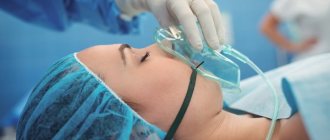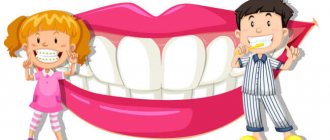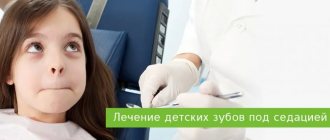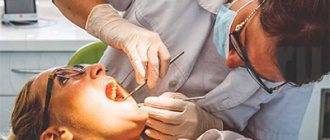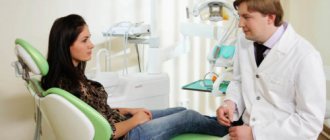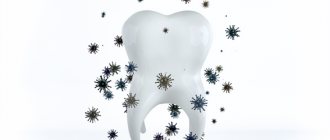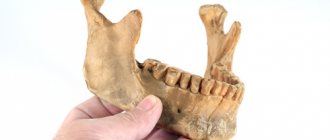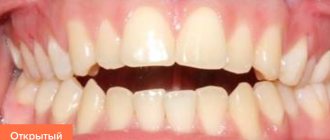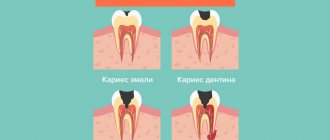Is going to the dentist really stressful for you? Fear and anxiety, muscle and psycho-emotional tension interfere not only with the patient, but also with the doctor. Premedication will help cope with this.
Premedication, or simply put, taking sedative medications, is carried out before pain relief and enhances the anesthetic effect. It is simply irreplaceable for those who are terrified of dental treatment. Especially for the youngest patients.
Why is premedication needed?
The purpose of premedication is to prevent possible reactions and complications during or after dental procedures, including achieving:
- suppression of fear;
- patient relaxation;
- elimination of the gag reflex;
- suppression of increased salivation;
- reduction of pain sensitivity;
- prevention of allergic reactions.
Types of nonspecific premedication
Sedative
Has a sedative effect. Reduces mental and emotional stress, eliminates fear and anxiety, and also enhances the effect of pain relief.
Half an hour to an hour before treatment, the patient is recommended to take tranquilizers or homeopathic sedatives of plant origin:
- The first include afobazole, diazepam, phenazepam, valocordin.
- The second includes tinctures of valerian, motherwort and peony, novopassit tenoten, corvalol.
Under their influence, a person relaxes, while remaining fully conscious. The effect lasts for several hours. If you have a panicky fear of dentists, it is better to take medications not only before visiting the doctor, but also on the eve of the scheduled visit.
Valerian and peony
Analgesic
Completely suppresses or significantly reduces the pain threshold, enhances the result of local anesthesia. The analgesic effect is achieved by taking painkillers - narcotic or non-narcotic. Half an hour to an hour before dental intervention, the following are prescribed: ibuprofen, ketrodol, xefocam-rapid, nubain, tempalgin, tramadol, tramal, fortal.
On average, the effect of analgesics lasts four hours.
Antiallergic
To prevent allergic reactions to local anesthetics and pseudo-allergic manifestations in response to a stressful situation for the body, patients are prescribed antihistamines.
Most often it is diphenhydramine, suprastin, claritin, tavegil. Other drugs are also used - Zyrtec, Kestin, Parlazan, Telfast.
Diphenhydramine, claritin, tavegil and suprastin also have a sedative and anti-inflammatory effect.
Cholinergic
Excessive salivation and the gag reflex are suppressed with a number of medications:
- atropine;
- haloperidol;
- glycopyrronium;
- droperidol.
Clozapine, metacin, Robinul and triftazine are used for the same purposes. Medicines are taken the day before dental procedures and/or half an hour before them.
Combined
In other words – combined. This type is most often used to eliminate several problems at once. Which types of premedication will be combined depends on the results of the anamnesis.
Local anesthesia
For most dental procedures, the use of local anesthetics is sufficient. Children usually tolerate freezing well, and modern drugs are safe and have minimal contraindications. Sensitivity of soft tissues is easily relieved with lidocaine, dicaine, benzocaine, bumecaine. The drugs are produced in different forms: water-based, oil-based solutions, in the form of gels, sprays, ointments.
Types of local anesthesia
Depending on the procedure, age, psychological mood of the child, pain relief is carried out using the application or injection method, as well as a combination of both.
Applications. Soft tissues in the treatment area are often treated with solutions, gels, and sprays based on lidocaine. The agents penetrate well into the mucous membranes and dull sensitivity. For some procedures, for example, removal of a loose baby tooth, an application is sufficient; in more complex cases, an additional injection is given.
Injections. The drugs are administered using a syringe. From the age of four you can use products with articaine, which are several times more powerful than novocaine anesthetics and are also safer. In pediatric dentistry, conduction (acts on the branch of the trigeminal nerve) or infiltration (reaches the endings of the dental nerves) anesthesia is usually performed. The second method is acceptable from the age of six.
Injection instruments
Classic syringes are gradually leaving children's clinics. Modern instruments make it possible to give injections less painfully and without psychological discomfort.
Through a needle-free injector, the drug enters the soft tissues under high pressure. Since there is no needle, the child does not experience strong fear.
In this case, the analgesic effect occurs faster due to the uniform distribution of the product.
The computer syringe also does not look like a regular one, so the injection is more comfortable. The dosage is controlled electronically, which allows saving on anesthetic, and the feeling of numbness after the injection is less pronounced.
A thinner needle is placed on the carpule syringe, which minimizes discomfort. The solution is contained in a sterile capsule to ensure precise dosing.
Premedication in pediatric dentistry
A different set of medications is recommended for children than for adults. Premedication regimens depend mainly on the age of the child.
Children from 0 to 3 years old are not given premedication.
- Children 3-6 years of age are prescribed phenobarbital and bromide-based sedatives the night before a visit to the dentist. Half an hour before the procedures, the same drugs and 10 drops of valerian tincture are taken again.
- 6-10 year old children are prescribed barbamyl, bromides and pipolfen before bedtime. 30 minutes before dental surgery, the medications are taken again along with vitamin B1.
- Adolescents under 15 years of age take diphenhydramine, phenobarbital, barbamyl and pipolfen before going to the dentist. Before a dental procedure, promedol, atropine, and aminazine are added to these medications.
Drugs that depress mental processes and the functions of the respiratory, circulatory and excretory systems are contraindicated for children.
Preparation for general anesthesia
The preparatory stage includes the following procedures:
- orthopantomogram;
- oral cavity examination;
- drawing up a treatment plan based on an x-ray image;
- collecting anamnesis using a questionnaire filled out by parents;
- consultation with a pediatric anesthesiologist and pediatrician;
- necessary laboratory tests;
- registration of written voluntary consent to the procedure.
The child must refuse food and liquids for a certain period of time before anesthesia to prevent the pharyngeal reflex. This period is determined by the anesthesiologist. As a rule, it is 6 hours for food, including kefir, milk, juices and pulp, and 4 hours for liquids. For children under one year old it is reduced to four hours.
Contraindications
- Liver diseases, for example, cirrhosis, Botkin;
- kidney diseases;
- myasthenia gravis – a disease that causes pathologically rapid fatigue of striated muscles;
- pregnancy and lactation;
- age up to three years.
There may be other individual contraindications, so you should act only under the guidance of a doctor.
Complications
If the procedure was carried out according to indications and in compliance with the dosage of medications, there should be no complications. However, some drugs have side effects and can cause a number of negative symptoms:
- hallucinations;
- dry mouth;
- rash;
- increased drowsiness.
Side effects go away on their own when the drug wears off. On average - four hours after administration.
Immediately after completing dental procedures, the doctor must make sure that the patient is in adequate condition, reacts normally to external stimuli, and feels well. If this is not the case, the dentist contacts the patient’s relatives and waits for their arrival.
Rubber dam system for general anesthesia
Under conditions of general anesthesia, the patient's oral cavity remains open for a long time, which increases the risk of drying out the mucous membrane and developing stomatitis. The rubber dam system allows you to avoid such a scenario and speed up manipulations. It isolates the mucous membrane from the effects of irritating drugs, prevents burns and accidental ingestion or entry of small instruments into the respiratory tract.
The system can be fixed to the entire dentition or to a quadrant - the patient does not need to keep his mouth open all the time. In this condition, dentists still have a wide field of view and can work on multiple teeth.
FAQ
Does premedication hurt?
Not necessary. Premedications can be taken orally, so there will be no pain. Injections, however, give better results.
Does it influence behavior?
Sometimes patients become more talkative and unreasonably cheerful. But such manifestations are extremely rare. If adverse reactions occur in the form of hallucinations and drowsiness, it is prohibited to drive. Until these symptoms go away, it is not recommended to engage in activities that require increased concentration. In other cases, after premedication, you can return to a normal lifestyle and do your usual activities.
Premedication in dentistry
Most patients experience severe psycho-emotional stress during a dental appointment.
A modern approach to dental treatment allows patients to relieve this stress. Basic dental interventions are performed on an outpatient basis, with the patient maintaining consciousness. During manipulations using local anesthesia, assessment and correction of the patient’s psycho-emotional state is important. The conditions necessary for outpatient dental interventions are provided with premedication.
Premedication is the drug preparation of the patient for medical procedures, aimed at reducing fear of treatment and reducing the level of psycho-emotional stress. Modern methods of which are sedation and analgosedation.
At the same time, among the main requirements for premedication are the following:
1. Creation of an optimal psycho-emotional state
2. Reducing the sensitivity threshold
3. Correction of adverse effects from the autonomic nervous system.
For premedication in outpatient dental appointments, it is usually recommended to use benzodiazepine tranquilizers:
phenozepam, diazepam (seduxen, sibazon, relanium), oxazepam (tazepam), elenium.
All these drugs have clinically useful antiphobic, sedative-hypnotic, anticonvulsant and muscle relaxant properties.
Possible side effects, such as a decrease in blood pressure, a decrease in cardiac output, and respiratory depression, are extremely rare and practically do not occur in somatically healthy patients.
The use of benzodiazepine drugs is contraindicated in patients with myasthenia gravis and glaucoma. Pregnant and breastfeeding women should not prescribe drugs from this group. Also, tranquilizers cannot be given to a patient in a dental clinic. A prescription for these drugs must be written by a doctor, and the patient must purchase these drugs from a specialized pharmacy independently.
Before premedication, it is necessary to carefully collect anamnesis, explain to the patient the purpose of this procedure, possible side effects, and obtain informed consent from him. Particular attention should be paid to the following factors:
- the patient did not take alcohol or sedatives within 24 hours before visiting the dentist;
- the patient must be sure that she is not pregnant;
- the patient has no contraindications to taking medications used for premedication;
- if premedication is given to a child, there must be an adult accompanying him who can take the child home and stay with him for the rest of the day;
- after using any sedative, the patient should not drive a car, operate any machinery or engage in activities that require increased attention and mental stress;
- it is not advisable for the patient to walk down the street unaccompanied, climb stairs, etc.;
- the patient should not take on any responsibility, look after children, etc.;
- the patient should not make important decisions, especially those related to legal and monetary issues, etc. during the whole day;
- The patient should not drink alcohol or use sedatives for 24 hours after visiting the dentist.
The use of “traditional” premedication using tranquilizers in outpatient dental practice is very problematic, both from an organizational and legal point of view.
In this regard, the possibility of using homeopathic medicines as premedication is of interest.
Homeopathy does not replace official medicine, but complements it.
If the patient does not have the opportunity to get an appointment with a homeopath, the dentist may prescribe Tenoten.
Tenoten eliminates anxiety, improves well-being and mood in patients with low, moderate and, especially effectively, with high levels of anxiety. Under the influence of this drug, the threshold for pain tolerance increases. Tenoten is effective in patients with both active and passive types of individual reactions to stress, while diazepam and phenazepam eliminate stress only in patients with active behavior. Tenoten does not cause changes in blood pressure, but it reduces the heart rate that increases with stress. After taking tenoten, the patient can perform his usual functional duties, including those related to fine motor skills, and carry out activities that require attention, concentration, clear orientation and memory, which is especially important when using the drug on an outpatient basis. It should be especially emphasized that tenoten is an over-the-counter drug. The use of tenoten is contraindicated in patients with increased individual sensitivity to this drug. It should not be prescribed to pregnant and breastfeeding women.
Premedication with tenoten is carried out taking into account the age and emotional status of the patient.
- In adult patients with a high degree of tension, anxiety and fear, it is recommended to use tenoten in a dose of 2+2 tablets (absorption under the tongue) with an interval of 55 minutes 20 minutes before the start of treatment.
- In adult patients with moderate levels of tension and anxiety, tenoten is used in a dose of 1+1 tablets (absorption under the tongue).
- In children with high or moderate levels of tension, anxiety and fear, it is recommended to use tenoten at a dose of 1 tablet (absorption under the tongue) 20 minutes before the start of treatment.
Prepared by: dentist Simanova O.N.
